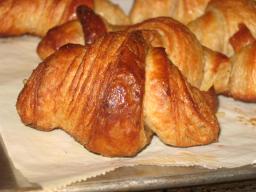
Challenge I found on a blog to go through PR's Whole Grain Book:
I found what is below posted on a blog and I joined up. I didn't know if some of you might want to follow along. Susie

I found what is below posted on a blog and I joined up. I didn't know if some of you might want to follow along. Susie

In my ongoing adventures with Peter Reinhart's Crust and Crumb, I decided to try one of the sandwich loaves. However, PR only presents a 100% white and 100% whole wheat in this book, and I really wanted to do a half-half. So did a biga starter today using 2 cups white and 1.5 cups whole wheat flour, figuring I'd use the white sandwich loaf recipe and adapt it using around 40% ww flour. Any advice on this?
Cheers
Lisa

I finally achieved the more than usually sour miche I have been trying for lately.
A 2Kg loaf, 70% hydration, 60% White Whole Wheat flour. I first had a larger percentage (close to 40%) of the final dough as a sour levain, mixed with cold-autolysed (18 hours) flour and water, along with salt and a little extra water for a second hydration.

Sometime last year I attempted to make sourdough bread but it didn't turn out very good. It was too sour and dense and very tough and so I gave it up. However my sourdough bagel baked last week was pretty successful, so I decided to made the baugette again.
Instead of using a 100% hydration poolish, I used a leaven from my sourdough starter.
Leaven
1 tablespoon of my sourdough starter
105g Water
105g Strong Bread Flour

Having baked well over a thousand breads over the years, I thought I’d write some things I’ve discovered while baking baguettes, batards, and boules. I’ve used techniques from many people – Bernard Clayton, Greg Patent, Julia Child, Peter Reinhart, Jim Lahey, others. I still change and experiment but, for better or worse, here are some things I’ve discovered. I’m not here to argue; just presenting. Take it or leave it.

Here are my recent bakes, one is 50% rye seeded (flax seed & sesame) bread and the orher is based on this recipe but 30% ww and 10% rye.

Did a batch of saltless white (70% hydration, fresh yeast, room-temp ferment + 2 proofings) to simulate bread I was eating in Italy during a recent vacation there, and got an OUTSTANDING crackle from the crust. You can even hear it over the noise of the oven fan in this YouTube video:
http://www.youtube.com/watch?v=3EHY5HSnLaw
Enjoy!